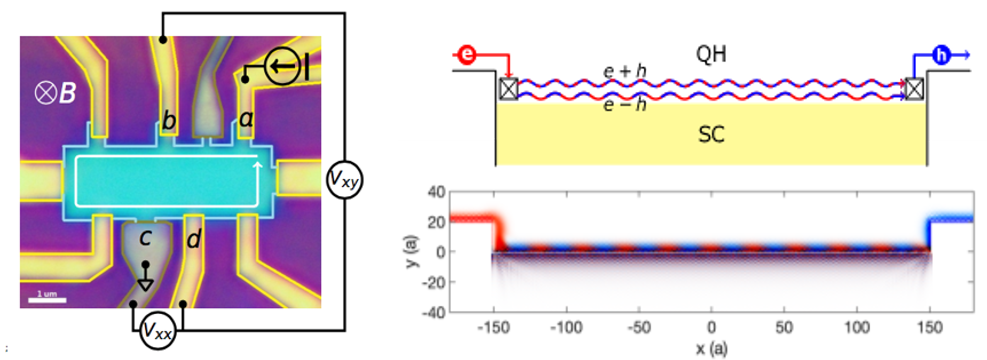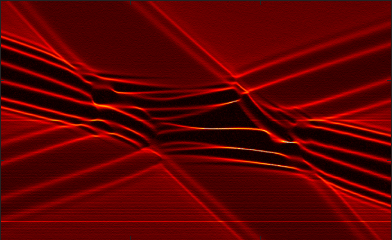Supercurrent in quantum Hall regime
Supercurrent in the quantum Hall regime and QH-based SQUID
The interplay of the quantum Hall effect and superconductivity is expected to result in novel excitations, such as chiral Majorana fermions (not to be confused with Majorana zero modes) and parafermions. Despite this potential, signatures of superconductivity in quantum Hall samples remained scarce, and it was questionable if superconducting current could flow through a QH region. In 2016, we reported on detecting supercurrent in the quantum Hall regime in Josephson junctions made from graphene encapsulated in hexagonal boron nitride.
The measurement was rather challenging – the signals we measured are up to 103–104 times smaller than the supercurrent through the same device at zero magnetic field. The origins of the suppression of supercurrent could be traced to the fact that the magnetic field in the QH regime breaks time-reversal symmetry, which is essential for the s-wave pairing of conventional superconductors.
Our group has explored supercurrent in the quantum Hall regime in a series of papers and eventually identified its most likely microscopic origins. In particular, by controlling the electron density near the edges of the sample we have built a quantum Hall-based SQUID.

Chiral Andreev edge states
In the QH regime, an electron propagating along the interface with the superconductor could be Andreev-reflected as a hole flowing in the same chiral direction. The hole could then be Andreev-reflected as an electron, etc. This combination of Andreev reflections with the QH chiral motion yields chiral Andreev edge states (CAES). Under certain conditions, CAES could become chiral Majorana fermions – charge neutral single-particle excitations. Simplistically, one could think of them as linear combinations of electron and hole states e + h and e – h.
We have detected CAES in a sample that has several normal and superconducting contacts. We observe pronounced and reproducible regions of negative non-local “downstream resistance” – the voltage on the downstream contact d drops below that of the grounded superconducting contact, indicating that electrons have been converted to holes. These and other experimental observations agree with the transport signature of chiral Andreev edge states.

Related Publications
Nonlocal transport measurements in hybrid quantum Hall-superconducting devices
Lingfei Zhao, Ethan G. Arnault, Trevyn F.Q. Larson, Kenji Watanabe, Takashi Taniguchi, Francois Amet, Gleb Finkelstein
Physical Review B (2024)
Loss and Decoherence at the Quantum Hall-Superconductor Interface
Lingfei Zhao, Zubair Iftikhar, Trevyn F.Q. Larson, Ethan G. Arnault, Kenji Watanabe, Takashi Taniguchi, Francois Amet, Gleb Finkelstein
Physical Review Letters (2023)
Interference of chiral Andreev edge states
Lingfei Zhao, Ethan G. Arnault, Alexey Bondarev, Andrew Seredinski, Trevyn Larson, Anne W. Draelos, Hengming Li, Kenji Watanabe, Takashi Taniguchi, Francois Amet, Harold U. Baranger, Gleb Finkelstein
Nature Physics (2020)
Quantum Hall-based Superconducting Interference Device
A. Seredinski, A. W. Draelos, E. G. Arnault, M. T. Wei, H. Li, K. Watanabe, T. Taniguchi, F. Amet, G. Finkelstein
ScienceAdvances (2019)
Supercurrent in Graphene Josephson Junctions with Narrow Trenches in the Quantum Hall Regime
A. Seredinski, A. Draelos, M. T. Wei, C. T. Ke, T. Fleming, Y. Mehta, E. Mancil, H. Li, T. Taniguchi, K. Watanabe, S. Tarucha, M. Yamamoto, I. V. Borzenets, F. Amet, G. Finkelstein
MRS Advances (2018)
Investigation of Supercurrent in the Quantum Hall Regime in Graphene Josephson Junctions
A. W. Draelos, M. T. Wei, A. Seredinski, C. T. Ke, Y. Mehta, R. Chamberlain, K. Watanabe, T. Taniguchi, M. Yamamoto, S. Tarucha, I. V. Borzenets, F. Amet, G. Finkelstein
Journal of Low Temperature Physics (2018)
Supercurrent in the Quantum Hall regime
F. Amet, C. T. Ke, I. V. Borzenets, Y-M. Wang, K. Watanabe, T. Taniguchi, R.S. Deacon, M. Yamamoto, Y. Bomze, S. Tarucha, and G. Finkelstein
Science (2016)
Corresponding Grad Students: Jordan McCourt (jordan.mccourt@duke.edu)
Chun-Chia Chen (chunchia.chen@duke.edu)
 Supercurrent in
Supercurrent in  Multi-terminal
Multi-terminal  High frequency measurements
High frequency measurements Dissipative quantum dots
Dissipative quantum dots